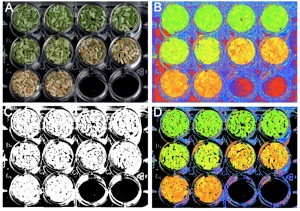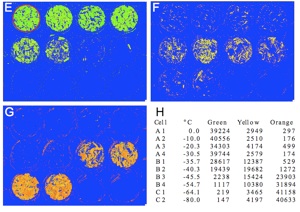Research:
Extreme frost tolerance in boreal conifers
Research:
Extreme frost tolerance in boreal conifers


Changes in freezing response curves during acclimation in needles of temperate coastal (top) and boreal (bottom) spruce species. Symbols represent three different trees of each species.
I study the mechanisms of extreme frost tolerance in boreal forest conifers such as Siberian spruce, (Picea obovata, a close relative of Norway spruce, P. abies), and Scots pine (Pinus sylvestris). Populations of these species live in Siberia, where winter temperatures often fall below -60˚C and can remain below -40˚C for weeks at a time. Understanding how these species survive such extreme cold may help predict their responses to global warming, and may also lead to improved methods of food, drug, cell, and tissue preservation by freezing or drying.
Working with the extensive conifer collection in the arboretum at the Ringve Botanical Garden, we compared the midwinter frost tolerance and acclimation and deacclimation processes in needles of boreal, temperate coastal, and temperate mountain species of spruce, pine, and fir. We found marked differences in their responses to freezing stress that indicate fundamental differences in the physiological and biochemical strategies they employ to survive freezing stress. In particular, boreal species can survive immersion in liquid nitrogen at -196˚C, provided they are first slowly cooled to -20 to -30˚C. This supports the hypothesis that the cell contents go through a glass transition (or vitrification) in this temperature range, whereby the water and dissolved substances in the cell become locked in a kind of molecular suspended animation that prevents cell damage at lower temperatures.
We have focused on sugars and proteins as likely contributors to extreme frost tolerance. These may help cells vitrify at relatively high temperatures, or interact directly with functional proteins and cell membranes to protect them from the effects of freezing stress.
Sugars accumulate in plant cells during frost hardening, and various studies have shown that they may have cryoprotective properties. Sucrose solutions also vitrify readily; many types of candy consist of flavored, vitrified sucrose. Working with Paul Schaberg at the U.S. Forest Service Northern Research Station in Burlington, Vermont, we have studied changes in sugar concentrations in temperate and boreal conifer needles during acclimation, through the midwinter period, and during deacclimation in the spring. Although the common plant sugar sucrose, a disaccharide, is most abundant, we found that the oligosaccharides raffinose and, in some species, stachyose are most closely associated with frost tolerance. Up to 45% of the total sugar in fully hardy boreal species is raffinose, and this sugar has a considerably higher vitrification temperature than sucrose.
In collaboration with the Umeå Plant Science Center, PhD student Trygve Kjellsen used 2D Difference Gel Electrophoresis (DiGE), a cutting-edge proteomic technique, to identify proteins that accumulate during early and late frost hardening in Picea obovata, the most frost tolerant species we have identified so far. Many of these proteins have known functions that are related to dormancy and frost hardening or other stresses, but there are also a number of unknown proteins that merit further study. Trygve also worked extensively with dehydrins, a group of non-enzymatic proteins that accumulate in during frost hardening and in response to certain kinds of stress. He has identified three different dehydrins associated with hardening in P. obovata, two of which accumulate during late acclimation as the needles achieve maximum frost tolerance. By isolating these dehydrins and testing them in cryoprotection assays, we hope to learn how they function in extreme frost tolerance.
In addition to isolating and characterizing dehydrins, I plan to continue proteomic work with other boreal conifer species and study vitrification as a mechanism of extreme frost tolerance. I would also like to expand my research into other aspects of the winter physiology of conifers, for example light stress or the tradeoff between frost tolerance and photosynthetic capacity in winter. As global warming results in dramatic changes in the physical environment of boreal forest ecosystems, an understanding of how the dominant tree species cope with warmer winters will help predict the consequences of and frame solutions to the challenge of global warming.

Raffinose concentration and frost tolerance in temperate and boreal species of fir, spruce and pine.


Image analysis procedure used to quantify color changes in needles after freezing stress and exposure to light.


A 2D gel, with proteins that are differentially expressed during frost hardening circled in red.

Quantification of necrosis (orange), chlorosis (yellow), and green needle tissue in samples of temperate (left) and boreal (right) fir species as affected by temperature after slow freezing (top), and slow freezing followed by quenching in liquid nitrogen at -196˚C (bottom).
Western blots of dehydrins in Picea obovata during acclimation and deacclimation, using K-segment antibody.